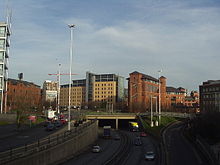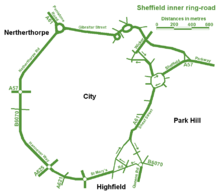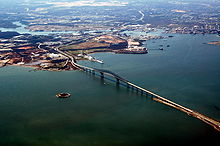- Ring road
-
A ring road, orbital motorway, beltway, circumferential highway, or loop highway is a road that encircles a town or city. The name "ring road" is used for the majority of metropolitan circumferential routes in the European Union, such as the Berliner Ring, the Brussels Ring, the Amsterdam Ring, the Boulevard Périphérique around Paris and the Leeds Inner and Outer ring roads. Australia also uses the term ring road, as in Melbourne's Western Ring Road.
In the European Union, some ring roads, particularly those of motorway standard, are often known as "orbital motorways", including the London Orbital, Manchester Orbital, Rome Orbital or the Madrid Orbital. In the United States, many ring roads are called beltways or loops, such as the Capital Beltway around Washington, D.C. Some ring roads, such as the Washington's Capital Beltway, use "Inner Loop" and "Outer Loop" terminology for directions of travel, since cardinal (compass) directions cannot be signed uniformly around the entire loop.
Contents
Background
Bypasses around many large and small towns were built in many areas when many old roads were upgraded to four-lane status in the 1930s to 1950s, such as those along the Old National Road (now generally U.S. 40 or Interstate 70) in the United States, leaving the old road in place to serve the town or city, but allowing through travelers to continue on a wider, faster, safer route. Construction of fully circumferential ring roads has generally occurred more recently, beginning in the 1960s in many areas, when the U.S. Interstate Highway System and similar-quality roads elsewhere were designed. Ring roads have now been built around numerous cities and metropolitan areas, including cities with multiple ring roads, irregularly shaped ring roads, and ring roads made up of various other long-distance roads. London has two ringroads: the London Orbital and the North and South Circular routes, as do the British cities Birmingham, Leeds, Norwich and Glasgow, along with Columbus, Ohio, in the United States.
Geographical constraints can complicate or prohibit the construction of a complete ring road. For example, the Baltimore Beltway in Maryland crosses Baltimore Harbor on a high arch bridge, and much of the partially completed Stockholm Ring Road in Sweden runs through tunnels or over long bridges. However, some towns or cities on seacoasts or near rugged mountains cannot have a full ring road, such as Dublin's ring road, or Interstate 495 around Boston, Massachusetts, neither of which completes the circle around these seaport cities. Similarly, Denver, Colorado, is bypassed to the east, but a circumferential route cannot be easily completed on the west due to the abrupt rise of the Rocky Mountains nearby. Adjacency of international boundaries may also prohibit ring road completion in other cases. Sometimes, the presence of significant natural or historical areas limits route options, as for the long-proposed Outer Beltway around Washington, D.C., where options for a new western Potomac River crossing are limited by a nearly continuous corridor of heavily visited scenic, natural, and historical landscapes in the Potomac River Gorge and adjacent areas.
When referring to a road encircling a capital city, the term "beltway" can also have a political connotation, as in the American term "Inside the Beltway", derived metonymically from the Capital Beltway encircling Washington, D.C.
Examples of ring roads
 The Leeds Inner Ring Road was built in a series of tunnels to save space and avoid physically separating the city's centre from its suburbs.
The Leeds Inner Ring Road was built in a series of tunnels to save space and avoid physically separating the city's centre from its suburbs.
Most orbital motorways (or beltways) are purpose-built major highways around a town or city, typically without either signals or road or railroad crossings. In the United States, beltways are commonly parts of the Interstate Highway System. Similar roads in the United Kingdom are often called "orbital motorways". Although the terms "ring road" and "orbital motorway" are sometimes used interchangeably, "ring road" often indicates a circumferential route formed from one or more existing roads within a city or town, with the standard of road being anything from an ordinary city street up to motorway level.
In some cases, a circumferential route is formed by the combination of a major through highway and a similar-quality loop route that extends out from the parent road, later reconnecting with the same highway. Such loops not only function as a bypass for through traffic, but also to serve outlying suburbs. In the United States, an Interstate highway loop is usually designated by a three-digit number beginning with an even digit before the two-digit number of its parent interstate. Interstate spurs, on the other hand, generally have three-digit numbers beginning with an odd digit.
Circumferential highways are prominent features in or near many large cities in the United States. In many cases, such as Atlanta, Georgia, Interstate 285 (also known as the Perimeter) serves as a bypass while other highways pass directly through the city center. In other cases, a primary Interstate highway passes around a city on one side, with a connecting loop Interstate bypassing the city on the other side, together forming a circumferential route, as in the area of Lawrence, Massachusetts. However, if a primary Interstate passes through a city and a loop bypasses it on only one side (as in the Wilmington, Delaware, area), no fully circumferential route is provided.
Route numbering is challenging when a through highway and a loop bypass together form a circumferential ring road. Since neither of the highways involved is circumferential itself, either dual signage or two (or more) route numbers is needed. The history of signage on the Capital Beltway around Washington, D.C., is instructive here. Interstate 95, a major through highway along the U.S. East Coast, was originally planned as a through-the-city route there, with the Beltway encircling the city as I-495. The portion of I-95 entering the city from the south was soon completed (and so signed), primarily by adapting an existing major highway, but the planned extension of I-95 through residential areas northward to the Beltway was long delayed, and eventually abandoned, leaving the eastern portion of the Beltway as the best Interstate-quality route for through traffic. This eastern portion of the Beltway was then redesignated from I-495 to I-95, leaving the I-495 designation only on the western portion, and the completed part of the planned Interstate inside the Beltway was redesignated as a spur, I-395. A few years later, the resulting confusion from different route numbers on the circumferential Beltway was resolved by restoring I-495 signage for the entire Beltway, with dual signage for I-95 for the highway's concurrent use as a through Interstate on its eastern portion.
Interstate 275 (Ohio–Indiana–Kentucky), is an 83.71-mile (134.72 km) loop in Ohio, Indiana, and Kentucky that forms a complete beltway around the Cincinnati, Ohio area. It is the only auxiliary interstate that enters three states, including one state that the parent route does not enter (Indiana). It is the longest loop highway in the United States.
References
See also
- Downtown circulator
- Link road
- List of ring roads
Categories:- Types of roads
- Orbital roads
Wikimedia Foundation. 2010.







